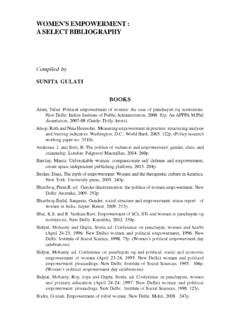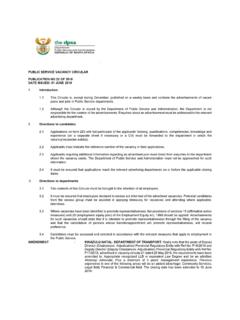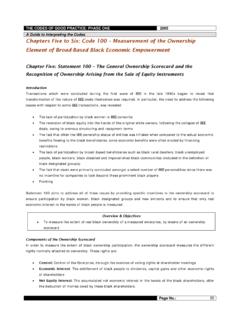Transcription of A decision guide for rural advisory methods
1 A decision guide for rural advisory methodsFood and Agriculture Organization of the United NationsRome, 2017 Soniia David and Francesca CofiniResearch and Extension unitFood and Agriculture Organization of the United Nations (FAO)A decision guide for rural advisory methodsThe designations employed and the presentation of material in this information product do not imply the expression of any opinion whatsoever on the part of the Food and Agriculture Organization of the United Nations (FAO) concerning the legal or development status of any country, territory, city or area or of its authorities, or concerning the delimitation of its frontiers or boundaries. The mention of specific companies or products of manufacturers, whether or not these have been patented, does not imply that these have been endorsed or recommended by FAO in preference to others of a similar nature that are not views expressed in this information product are those of the author(s) and do not necessarily reflect the views or policies of 978-92-5-130019-0 FAO, 2017 FAO encourages the use, reproduction and dissemination of material in this information product.
2 Except where otherwise indicated, material may be copied, downloaded and printed for private study, research and teaching purposes, or for use in non-commercial products or services, provided that appropriate acknowledgement of FAO as the source and copyright holder is given and that FAO s endorsement of users views, products or services is not implied in any requests for translation and adaptation rights, and for resale and other commercial use rights should be made via or addressed to information products are available on the FAO website ( ) and can be purchased through citation:David, S. and Cofini, F. 2017. A decision guide for rural advisory methods . Rome, decision guide for rural advisory methodsContents Introduction ..1 Outline of the guide .
3 4 Some general considerations for using the guide ..6 Section 1 methods description sheetsBenchmarking for farm business analysis ..8 Demonstrations ..9 Farmer learning groups ..10 Fairs, shows and rallies ..11 Farmer-to-farmer extension ..12 Village-based self-emplyed agents ..13 Farmer field schools ..14 Junior Farmer Field and Life School ..15 Farmer business school ..15 Household methodologies ..16 Innovation platforms ..17 Learning events ..19 Courses ..19 Workshops ..20 Management advice for family farms ..21 Mobile phone ..22 Village-based information providers ..23 Plant clinics ..24 Radio ..25 Radio campaigns ..27 Radio listeners group ..28 Radio drama ..28 rural resource centres ..29 Study circles ..30 Study tours ..31 Television ..32 Video.
4 34 Facilitated video viewing in groups ..35 Some tools used in agricultural extensionParticipatory learning and action ..36 Printed materials ..36 Social media ..37 Games ..37 Folk media ..37 Section 2 Deciding which method to useHow to use the decision matrix ..40 The decision matrix ..42 References and resources ..44ivA decision guide for rural advisory methodsIntroductionAcknowledgementsAutho rs Soniia David and Francesca Cofini, Research and Extension Unit, reviewersKatheleen Colverson, University of Florida, Dosov, Central Asia and the Caucasus Forum for rural advisory Services (CAC-FRAS)Agustina Malvido, Instituto Nacional de Tecnolog a Agropecuaria (INTA), ArgentinaMargaret Mangheni, Makerere University, UgandaPatrice Djamen, R seau des Services de Conseil Agricole et rural d Afrique de l Ouest et du Centre (RESCAR)
5 John Preissing, FAOvA decision guide for rural advisory methodsIntroductionAcronymsAESAAgro-ecos ystem analysisEASE xtension and advisory servicesFBSF armer business schoolFLGF armer learning groupF2 Ffarmer to farmerF2 FEfarmer-to-farmer extensionFOFarmer OrganizationICTinformation and communication technologyIPinnovation platformIVRinteractive voice responseJFFLSJ unior Farmer Field and Life SchoolMAFFM anagement Advice for Family FarmsNGOnon-governmental organizationPLAparticipatory learning and actionPRCparticipatory radio campaignRASrural advisory serviceRRCR ural Resource Centre SCstudy centreSMSsmall message serviceSTstudy tourTVtelevision1A decision guide for rural advisory methodsIntroduction In today s fast-changing world, agricultural producers need support to innovate1 as well as reliable sources of information, knowledge, skills and technologies along the entire value chain in farming, livestock and fish production.
6 The role and functions of agricultural extension and rural advisory services (RAS) has changed significantly since the 1980s in response to the changing nature and growing complexity of agricultural and rural environment. Changes in extension have been characterized by the involvement of a broader range of RAS providers (NGOs, private sector actors, producer organizations) beyond the public sector, efforts to make rural advisory services more demand driven, with a wider focus on rural livelihood needs. The traditional production-oriented, technology transfer role of extension has shifted towards emphasizing farmer participation and empowerment, catalysing and facilitating innovation processes, building linkages between farmers and other rural stakeholders, so as to enhance market linkages, strengthen entrepreneurship and improve access to inputs and credit.
7 Additionally, the RAS mandate has broadened from a production and productivity focus to include food security, climate change, nutrition, gender, and health, among other these changes, one of the core functions of extension services remains to facilitate the access of farmers, their organizations and other market actors to knowledge, information and technologies (Christoplos, 2010). To carry out these multi-faceted functions, extension professionals, and their organizations, need to utilize a broad range of methods and approaches. While nearly every extension and RAS programme and project has developed guidelines on how to use and evaluate extension methods and approaches, there is a lack of detailed information and guidance on what factors need to be considered when selecting extension and advisory methods and approaches that are most suited for which purpose and content.
8 This has resulted in a tendency by some service providers to take a one size fits all approach, using a single or only a few methods and approaches. Inappropriate selection and use of extension methods may limit the effectiveness of service provision, resulting in diminished impact and a failure to meet clients decision guide is intended to help extension professionals and their organizations make informed decisions about which extension method and approach to use for providing information, technologies and services to rural producers and to facilitate interactions and knowledge flow. Expected users include field-based rural advisors, extension managers and programme Innovation is the process by which individuals or organizations master and implement the design and production of products (including technologies), processes and forms of organizations that are new to them, irrespective of whether the innovation has been used by others.
9 2A decision guide for rural advisory methodsIntroductionThe guide focuses on the following advisory methods and their variations2:>>Benchmarking for farm business analysis>>Demonstrations: farmer learning groups>>Fairs, shows and rallies>>Farmer-to-farmer extension: village-based self-employed agents>>Farmer field school: junior farmer field schools, farmer business school>>Household methodologies>>Innovation platforms>>Learning events: courses and workshops>>Management Advice for Family Farms >>Mobile phones (mExtension): village-based information providers>>Plant clinics>>Radio: radio campaigns, radio listeners groups, radio drama>> rural resource centres>>Study circles>>Study tours>>Television>>Video: facilitated video viewing in groups This collection of methods , identified through an extensive literature review, is by no means exhaustive but includes those methods that have been widely used and documented.
10 All methods included in this guide have been implemented by different types of RAS providers, notably, public extension agencies, NGOs, private sector actors and farmer organizations. The guide also describes five tools commonly used by agricultural extension and advisory services: namely participatory learning and action, printed materials, social media, games and folk A variation is an off-shoot of a method which differs from the original method or approach while still respecting the basic principles while maintaining some aspects. 3A decision guide for rural advisory methodsIntroduction Key terms defined Extension and rural advisory servicesExtension and advisory philosophiesAdvisory approachAdvisory methodsTools All the different activities that provide the information and services needed and demanded by farmers and other actors in rural settings to assist them in developing their own technical, organizational and management skills and practices so as to improve their well-being (Christoplos, 2010).















